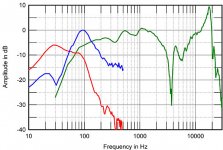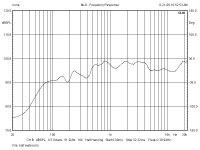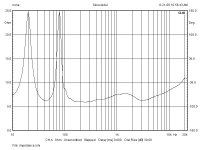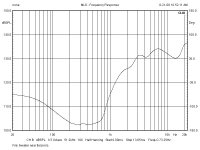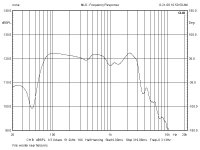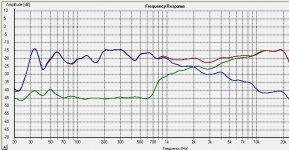Time domain is important and is something even very basic speaker designs have that sound half way decent. Its nothing new or groundbreaking. Vandersteen does it too and doesn't charge the kind of money Wilson does, and they're not as hard to drive either. Building a crossover potted makes it unserviceable, so you're stuck buying a whole new unit. Thats idiotic.Said no one. Also leaving out the most basic Dave Wilson philosophy and research about time domain, for example.
So any company that wants to protect its trade secrets, and perhaps, one of the reasons for their success, is a snake oil salesman. Good to know.
Not saying that Wilson is the only one delivering designs with time domain, or that he even invented the concept, but you simply can't deny, that he's taken it to another level with the amount of detail that comes with his speakers.Time domain is important and is something even very basic speaker designs have that sound half way decent. Its nothing new or groundbreaking. Vandersteen does it too and doesn't charge the kind of money Wilson does, and they're not as hard to drive either. Building a crossover potted makes it unserviceable, so you're stuck buying a whole new unit. Thats idiotic.
How many "regular consumers" do you know that would want to "tear" into their speaker, of any brand or price, to service their crossover?
Now that is very unfair: we cannot expect a manufacturer to connect mid and tweeter with the correct polarity for a mere 50K Bucks. For the correct polarity you need to cough up another 50K.
Please post link to the Stereophile measurements.No further comments except it also dips below 2 Ohms.
View attachment 1083436
No further comments except it also dips below 2 Ohms.
Now that is very unfair: we cannot expect a manufacturer to connect mid and tweeter with the correct polarity for a mere 50K Bucks. For the correct polarity you need to cough up another 50K.
That is why I asked for link to the Stereophile measurements. Measured frequency graph out of context is misleading - that huge hole between 3 and 4 kHz is the result of near-field measuring (microphone very close to midwoofer), not the result of wrong polarity.
Here is measured frequency response of WATT 3 (without Puppy) at 45" distance, from the same review:
As you can see, there is no hole between 3 and 4 kHz.
But I agree WATT/Puppy is a bad design - for the same price there are many other loudspekers with much better sound quality, much better measurements and much better engineering.
Yes agree, that was not entirely fair - sorry 🥹.That is why I asked for link to the Stereophile measurements. Measured frequency graph out of context is misleading - that huge hole between 3 and 4 kHz is the result of near-field measuring (microphone very close to midwoofer), not the result of wrong polarity.
Here is measured frequency response of WATT 3 (without Puppy) at 45" distance, from the same review:
View attachment 1083505
As you can see, there is no hole between 3 and 4 kHz.
But I agree WATT/Puppy is a bad design - for the same price there are many other loudspekers with much better sound quality, much better measurements and much better engineering.
Hello. I have two questions. First is what impedance has the Scan Speaker driver,(4 or 8Ohm) and second one is there no wadding in the Watt enclosure, only couple of sheets of neopren? Puppy is full of wadding for an instance. Thx for any info.
Regards,
JR.
Regards,
JR.
You are wrong, the graph with the hole between 3-4 kHz is not measured from very close to the mid-woofer. It's 45" from the tweeter. "Wilson WATT 3, anechoic response on tweeter axis at 45", corrected for microphone response, with WATT 3 nearfield woofer when driven by the Puppy crossover plotted below 200Hz (green) and Puppy woofer (blue) and port (red) responses plotted below 400Hz, respectively."That is why I asked for link to the Stereophile measurements. Measured frequency graph out of context is misleading - that huge hole between 3 and 4 kHz is the result of near-field measuring (microphone very close to midwoofer), not the result of wrong polarity.
Here is measured frequency response of WATT 3 (without Puppy) at 45" distance, from the same review:
View attachment 1083505
As you can see, there is no hole between 3 and 4 kHz.
But I agree WATT/Puppy is a bad design - for the same price there are many other loudspekers with much better sound quality, much better measurements and much better engineering.
I fully agree. Measurement was done at a distance of 45” with the mic placed on an axis horizontal with the tweeter.You are wrong, the graph with the hole between 3-4 kHz is not measured from very close to the mid-woofer. It's 45" from the tweeter. "Wilson WATT 3, anechoic response on tweeter axis at 45", corrected for microphone response, with WATT 3 nearfield woofer when driven by the Puppy crossover plotted below 200Hz (green) and Puppy woofer (blue) and port (red) responses plotted below 400Hz, respectively."
This exact measuremen has puzzled me all these years, since logically it would indicate, that Dave Wilson chose to take the Seas 6,5” all the way up to its natural roll off. What supports this measurement is statement from PS Audio saying, that the crossover is no more than a coil and a capacitor. How they would know is beyond me….
Dave Wilson back then always stated, that crossover frequency was in the region of 1,8 kHz.
Here is measurements of WP6. anyone who are capable to read it understand what order slopes ( electrical+acoustcaly and which is which) . we cant measure WP on tweeter axis. acuostical phase in factory set much lower than that. Scan speak based midrange(which 4 ohm to someone who asked) have pretty much high mms so quite sharp ACOUSTIC roll off. I have dismantled ORIGINAL xover. its not reversible operation and most parts were damaged during that. There definatley NOT "only cap and inductor" crossover. I wonder why people claims such things. I hope I answered all questions. I seeing no point return to already answerd questions however. good luck.
Attachments
Why do you measure the tweet and midwoofer NF instead of individually at 1 meter? NF is not going to yield very accurate results around x/o (which at first sight looks like a bit over overlap anyway..)
My apologies. I just simply forget my mobile 200m2 anechoic chamber at home because I was in a hurry. 🤔Why do you measure the tweet and midwoofer NF instead of individually at 1 meter? NF is not going to yield very accurate results around x/o (which at first sight looks like a bit over overlap anyway..)
You write about version 6, but different loudspeakers than WP3. They have different drivers, so definitely a crossover. Your measurements are strange. This is exactly how SS midbass looks without crossover and from 30 degrees. It is at 120dB, but the tweeter is at 130dB. Did you measure from the same distance? Nothing valuable can be learned from those measurements.Here is measurements of WP6. anyone who are capable to read it understand what order slopes ( electrical+acoustcaly and which is which) . we cant measure WP on tweeter axis. acuostical phase in factory set much lower than that. Scan speak based midrange(which 4 ohm to someone who asked) have pretty much high mms so quite sharp ACOUSTIC roll off. I have dismantled ORIGINAL xover. its not reversible operation and most parts were damaged during that. There definatley NOT "only cap and inductor" crossover. I wonder why people claims such things. I hope I answered all questions. I seeing no point return to already answerd questions however. good luck.
None of us have an anechoic chamber at home and this is what it looks like from 1 meter away. (no Wilson speaker)My apologies. I just simply forget my mobile 200m2 anechoic chamber at home because I was in a hurry. 🤔
Attachments
Elviukai,Here is measurements of WP6. anyone who are capable to read it understand what order slopes ( electrical+acoustcaly and which is which) . we cant measure WP on tweeter axis. acuostical phase in factory set much lower than that. Scan speak based midrange(which 4 ohm to someone who asked) have pretty much high mms so quite sharp ACOUSTIC roll off. I have dismantled ORIGINAL xover. its not reversible operation and most parts were damaged during that. There definatley NOT "only cap and inductor" crossover. I wonder why people claims such things. I hope I answered all questions. I seeing no point return to already answerd questions however. good luck.
Thanks for sharing some of your measurements. I have notice, that you have studied WATT-Puppies and their drivers in depth using original Wilson speakers.
Your measurements on the WATT6 are in line with John Atkinsons findings on the later Sasha W/P, which shared similar crossover point and steepness of slopes for both midwoofer and tweeter (and later the newest Sasha DAW but with totally different drivers).
As I remember the WATT6 was Wilson’s first move towards a more musical approach compared to the former versions more analytical tendency.
Did you ever analyse the WATT3?
It’s correct, that Wilson factory design axis for the WATT was lower than tweeter axis. However, Atkinson made the measurement at tweeter axis to comply with his measurement protocol and thus make comparisons to other speakers possible (on that given axis and distance).
PANDINUS,None of us have an anechoic chamber at home and this is what it looks like from 1 meter away. (no Wilson speaker)
Is your measurement of the WATT6 as elviukai or the WATT3?
Quite interesting difference…
As elviukai’s measurements was done in the near field those SPL-figures are hardly surprising but proportional to input signal voltage.
SMABB,
I wrote ( No Wilson speaker) They are some speakers with crossovers of the first order In the measurements from elvikai, I am not surprised by the high level, but the 10dB difference between the woferr and the tweeter He also writes that the woofwr is 4 ohm, but the impedance curve shows a prime example of an 8 ohm speaker. The minimum there is 7 Ohm. The whole measurement thing is confusing.
I wrote ( No Wilson speaker) They are some speakers with crossovers of the first order In the measurements from elvikai, I am not surprised by the high level, but the 10dB difference between the woferr and the tweeter He also writes that the woofwr is 4 ohm, but the impedance curve shows a prime example of an 8 ohm speaker. The minimum there is 7 Ohm. The whole measurement thing is confusing.
- Home
- Loudspeakers
- Multi-Way
- Schematic of potted crossover network for Wilson's Watt V/Puppy V.1 wanted
